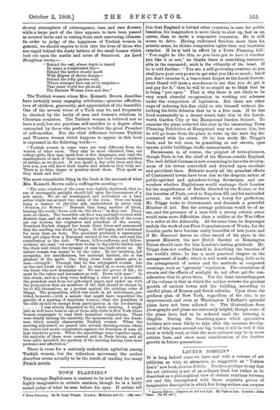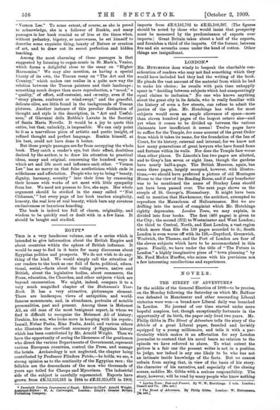LAURUS NOBILIS.*
IT is long indeed since we have met with a volume of art criticism so wise, so attractive, so suggestive as "Vernon Lee's" new book, Lawras Nobilis. Needless perhaps to say that the art criticism is not of an ordinary kind, but rather to be described as a philosophical view of certain relations between art and life, interspersed with those exquisite pieces .of imaginative description in which few living writers can surpass * /our= : Chapars. on Art and No. By Vernon Lee. london: John
Zane. [S.:6d. not.] _
"Vernon Lee." To some extent, of course, as she is proud to acknowledge, she is a follower of Ruskin, and many passages in her book remind us of him at the times when, without pedantry, bigotry, or narrowness, he set himself to describe some exquisite thing, beauty of Nature or creation of art, and to draw out its secret perfection and hidden teaching.
Among the most charming of these passages is that suggested by listening to organ-music in St. Mark's, Venice, which forms a delightful close to the essay on "Higher Harmonies." We may also mention, as having a special b!auty of its own, the Tuscan essay on "The Art and the Country," which makes one realise in a quite new way the relation between the Tuscan painters and their landscape ; something much deeper than mere reproduction, a "mood," a "quality," of effort, self-restraint, and te...enity, even if the "stony places, sunburnt or wind-swept," and the graceful, delicate olive, are little found in the backgrounds of Tuscan pictures. Another instance of this peculiar distinction of thought and style is the description, in "Art and Useful- ness," of Giovanni della Robbia's Lavabo in the Sacristy of Santa Maria Novella. It would be a joy to quote this entire, but that, unluckily, is impossible. We can only point to it as a marvellous piece of artistic and poetic insight, of refined thought and perfect language. Ruskin himself, at his best, could not have done it better.
But these purple passages are far from occupying the whole book. They catch a reader's eye, but their effect, doubtless desired by the author, is to draw his attention to practical ideas, many and original, concerning the hundred ways in which art and life meet and influence each other. "Vernon Lee" has no mercy on that false aestheticism which ends in selfishness and affectation. People who try to bring " beauty, dignity, harmony, serenity" into their lives by cramming their houses with works of art meet with little sympathy from her. We need not possess to live, she says. Her whole argument should be studied in the essay called "'Nisi Citharam,' " but every page of her book teaches simplicity, honesty, the real love of real beauty, which bars any covetous exclusiveness or luxurious hoarding.
The book is indeed too full of charm, originality, and wisdom to be quickly read or dealt with in a few lines. It should be bought and studied.



























































 Previous page
Previous page